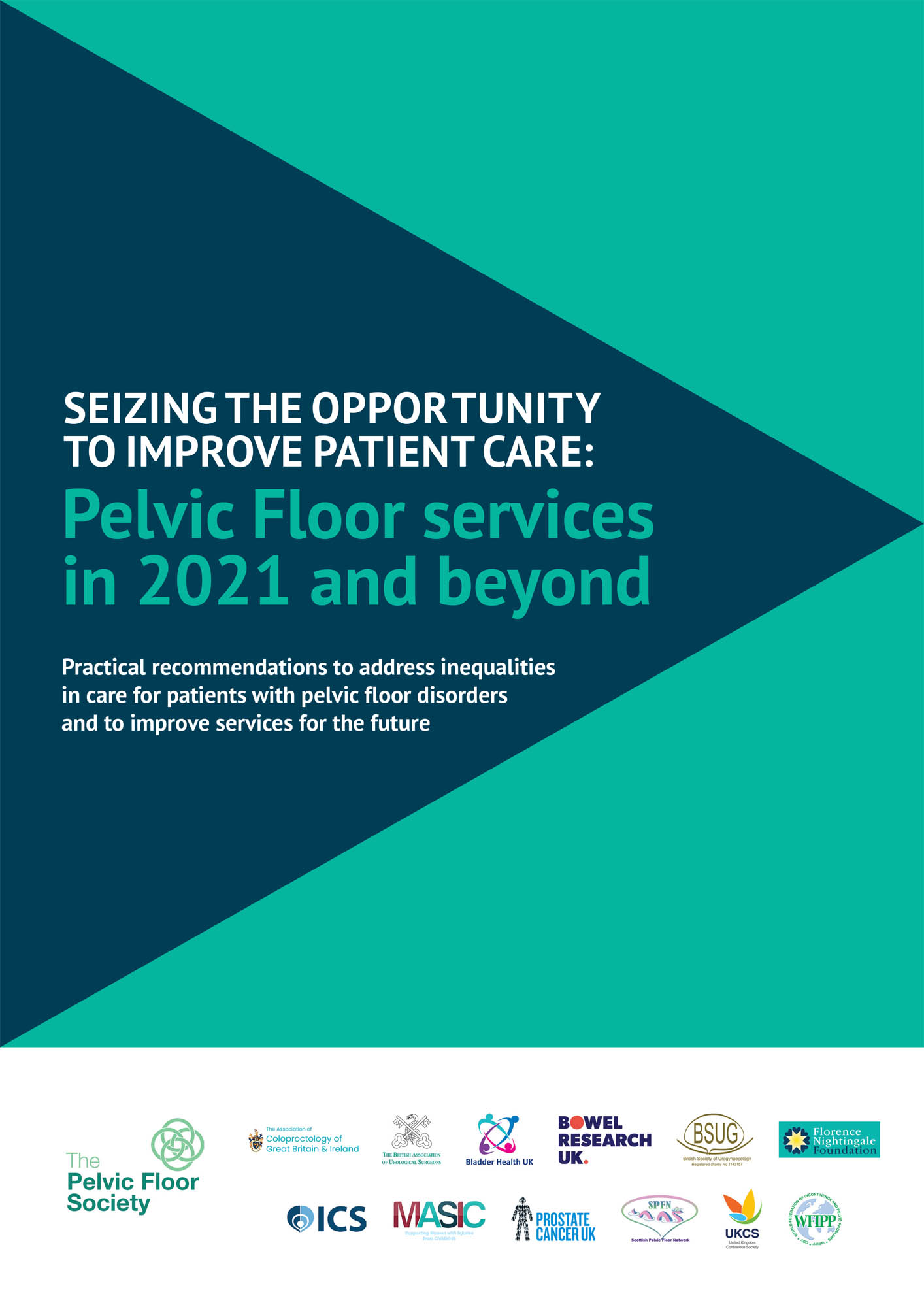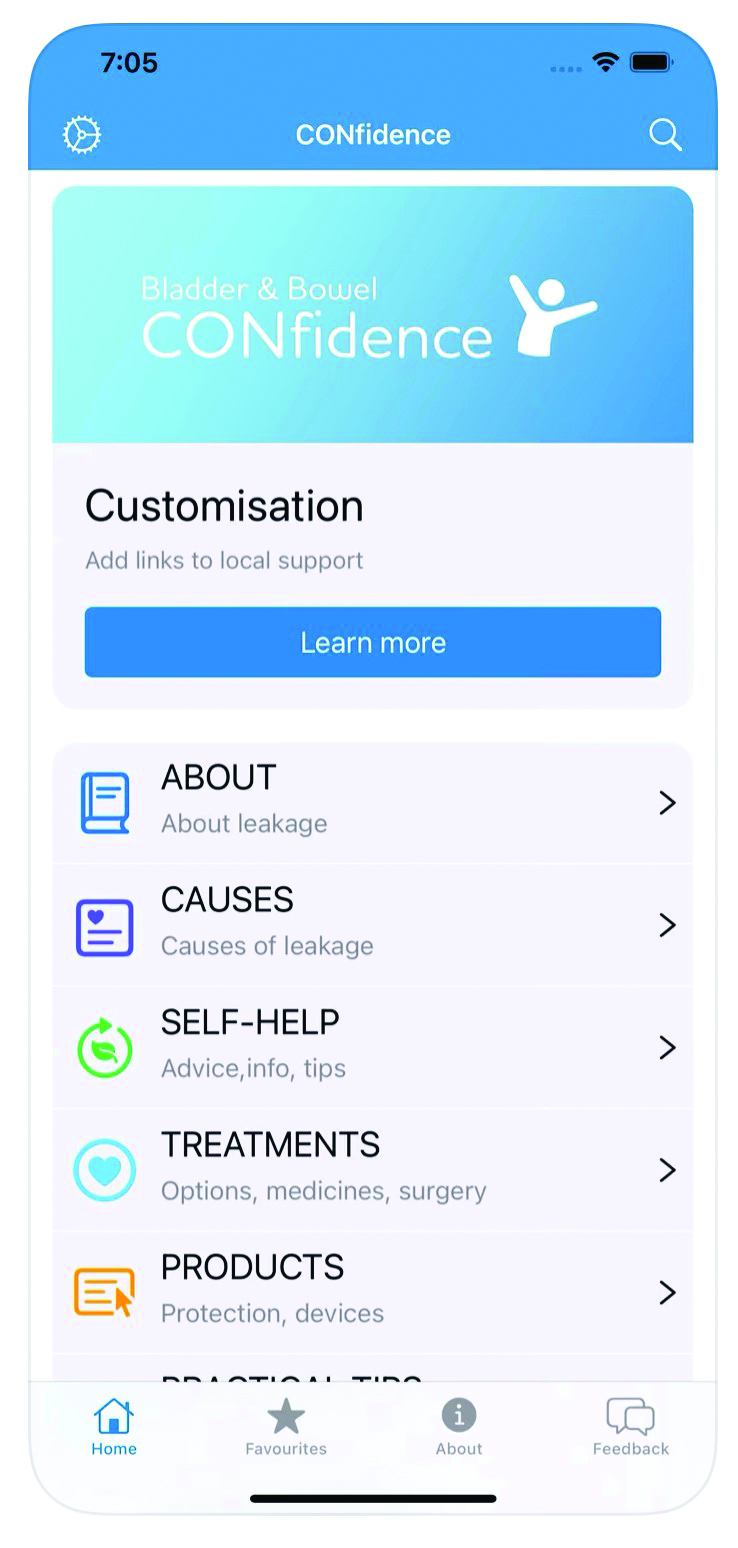

A
How to engage and educate patients, healthcare professionals and the public about Pelvic Floor disorders and their treatment
Lesley Booth, Suzanne Evans, Susannah Fraser, Tracy Stewart
Pelvic floor issues leading to bladder and/or bowel incontinence cause a strong sense of taboo and embarrassment, to a greater extent than other medical conditions (Elenskaia et al., 2011). This can dissuade patients, including 50–70% of women, from consulting a doctor (Medscape, 2019; Leigh et al., 1982). While up to 31% of older men may experience urinary incontinence, only around 1 in 5 of those with frequent issues have ever contacted a healthcare professional for help (Shamliyan et al., 2009).
Many patients are unaware that there are options to treat incontinence and that it should not be accepted as a natural part of ageing, an expected consequence of childbirth, or a typical part of delayed development in children and young people. Some members of the large and growing adult incontinence industry (Nonwovens Industry Magazine, 2019), have been accused of normalising incontinence within advertising (BBC, 2019), although since then, banners on TV advertisements have started to suggest that patients seek medical advice. A lack of widespread promotion of bladder and bowel health adds to the problem, with many people unaware that incontinence is not only an adverse medical condition but may also be a symptom of a more serious condition, such as bladder (Medscape, 2019) or gastrointestinal (Adelborg et al., 2019) cancer, and should always be checked.
Patients experiencing the symptoms of incontinence may be dissuaded from seeking medical help not only from embarrassment, but also from fear of surgical interventions, or that there is nothing that can be done. Or, quite simply, they find that their condition is not taken seriously by their GP, who may not understand the emotional impact of a continence issue.
A lack of education on incontinence and awareness of the availability of conservative treatment options, among both patients and GPs, is contributing to the issue.
The end result is that patients often wait for years to report their problem, and once they do present their pathway to treatment is often not straightforward – leading to years of unnecessary suffering.


KEY POINTS
- Patients must be empowered, by information and support, to present for treatment and to refer themselves if necessary
- Improved education is a must for health professionals in primary care, particularly GPs and nurses
- A national, well-funded campaign would help to raise awareness not only of the options available for patients, but of the importance of bladder and bowel health to prevent disease; reducing or removing the taboo is essential. The NHSE-commissioned National Bowel and Bladder Health project will hopefully start to address this
The empowered patient: signposting the pathway to find help
The patient pathway, the sequence of assessments and therapies undergone by a patient to address their condition, needs to be more clearly communicated and more strongly mandated for pelvic floor disorders and incontinence. Pelvic floor health should be included as standard in the opening discussions of GPs, district nurses, health visitors, and other health professionals with new patients, particularly pregnant women and those most likely to be susceptible (for example, those who have undergone surgery). While continence pads are important, they should not be the end of the discussion for any patient with pelvic floor problems. That said, a postcode lottery in the UK leads to many patients buying their own: some GPs are not allowed to prescribe even pads without a formal diagnosis, which can be hindered by the delays in secondary care.
Patients must be made aware that treatment is available and that a number of conservative and minimally invasive interventions are an option before the last resort of surgery. Early intervention can reduce the chance of long-term conditions requiring invasive treatment, and improve patient outcomes.
If a patient cannot find support in primary care, self-referral is an option. Bladder and bowel community continence services should be made as accessible as possible – or as a minimum, specialist nurses or appropriately trained AHPs should be engaged to serve the local population.
Patients may, however, not be aware of local services and how to reach them: regional listings of services should be made available to ensure they are empowered to take this step. Partnerships with industry could be highly beneficial here: the packaging of incontinence products is an ideal location for information and guidance on how to find support. Manufacturers have made strides in recent years to provide more health information and advice on websites and consumer and healthcare professional materials. A number also run helplines with medical or product advisors.
Once on the treatment pathway, patients can find the journey confusing and frustrating. Reports from multidisciplinary team (MDT) meetings (see Chapter C) are not often shared with the patients whose cases were discussed, but this can help them to understand what was suggested, what was agreed and the ultimate outcome – potentially increasing trust as well as understanding.
CASE STUDY: ANDREW’S STORY
Starting at the age of 21, Andrew suffered from faecal urgency – the urgent need to rush to the toilet and vacate his bowels, which became a daily pattern. Over the following 18 years, Irritable Bowel Syndrome was among the diagnoses proposed and doctors suggested diet changes, which Andrew faithfully followed. A number of drugs, including codeine and loperamide, were tried and Andrew underwent countless investigations.
Nothing worked.
For all this time, Andrew lived in fear of unexpected events where he might not have easy access to a toilet. Getting stuck in traffic was terrifying. The associated social isolation and anxiety left him exhausted.
Eventually, after almost two decades, new treatments were tried with great success: percutaneous tibial nerve stimulation (PTNS) and finally sacral neuromodulation (SNM). At last, Andrew can enjoy a walk in the woods and feels he is back in control of his life.
Andrew’s story can be read in full, in his own words, at www.bowelresearchuk.org/stories.
The educated healthcare professional: provide education and training for GPs and nurses
GPs have a broad educational curriculum, which must include adequate training on pelvic floor disorders and their treatment. GPs should be aware of the appropriate referrals for their patients, as well as the community-based, minimally invasive treatment options available. A listing of regional services, as well as being helpful for patients, would be invaluable to GPs in this regard.
Nurses and carers (particularly those who work in care homes) are a major source of information and support for patients and thus their education should also include the range of treatment options available for incontinence. In addition, ways to support and maintain bladder and bowel health – such as an appropriate diet – should be included in nurses’ training in order that they can pass this knowledge on to their patients.
Updated national guidelines are an important tool to improve HCP awareness, as well as supporting joined-up care, and would be welcomed.
CASE STUDY: MOVEMBER
Men have historically been unwilling to discuss their health, particularly with regard to mental health and diseases like prostate and testicular cancer. Founded in 2003, the Movember campaign takes a light-hearted approach to men’s health, calling out the stigmas and drawing attention to the health issues affecting men. As well as funding over 1250 health projects in more than 20 countries (Movember Annual Report, 2020), the campaign has reinvigorated the conversation around men’s health.
An engaged public: a national awareness and education campaign
One of the biggest problems with addressing the issue of incontinence is the associated taboo and embarrassment. A broad, friendly, national campaign, with accessible and memorable branding, can help to start a conversation around pelvic floor disorders and the help available. Such a campaign could perhaps be timed to coincide with World Continence Week (17–23 June in 2021), or a UK-specific Continence Awareness Month could be launched to bring together all the different specialties.
Appropriate use of language, such as describing incontinence as a ‘life-limiting’ or ‘life-changing’ condition, can also help to adjust perspectives and attitudes. Industry, as well as government bodies, could be a source of funding for such a campaign, and could also support the campaign through product packaging and advertising to ensure a wide reach.


[The closure of public toilets] had a serious impact on where I was able to go. I had to cut short walks in order to get home in time and every trip or activity had to carefully considered to see if [it] was possible. When I did venture out there was a continuous worry that I wouldn’t manage ok. This spoiled what should have been an enjoyable and relaxing experience.”
Jane, Patient with interstitial cystitis
Incontinence should not be seen as a normal part of life, to be endured rather than addressed. Early and universal education, targeting both children and adults, including those with physical and learning disabilities (particularly those undergoing relevant life events such as pregnancy or surgery), can help to ensure people are aware of the steps to take to maintain their bladder and bowel health, key signs to be aware of and the steps to take if they suspect a problem (Arbuckle et al., 2019). Leaflets are not universally permitted in GPs’ surgeries: allowing these to be displayed in surgeries throughout the country would be a major step forward.
Schools, along with school and community nurses, have an important part to play to ensure that children, along with their parents, understand how to maintain bladder and bowel health, and whom to turn to if they have a problem. Incontinence is seen in adolescents and young people (Arbuckle et al., 2019; Gram & Bø, 2020), but many are unaware of the existence of the pelvic floor or of how to train and protect it (Gram & Bø, 2020; Parden et al., 2016). The children’s bowel and bladder charity, Eric (https://www.eric.org.uk/), and Bladder & Bowel UK, are heavily involved in raising awareness: this work should be encouraged and continued. The Association for Continence Advice has been heavily involved in producing videos and information sheets, for example on how to perform pelvic floor exercises, which can help to support young people to maintain their pelvic floor health. This is particularly key for children, as paediatric incontinence is a trigger for domestic violence towards children (Bennett, 2014). Care must be taken, however, to ensure that ‘healthy living’ is distinguished from serious disorders such as inflammatory bowel disease.


CASE STUDY: BABCON
In and around Bristol, the Bladder and Bowel CONfidence Health Integration Team (BABCON HIT) aims to promote bladder and bowel continence. This city- and system-wide engagement approach to continence promotion involves academia, healthcare, local authority, patients and the public. The team works to both raise awareness and drive improvements in care, by improving services and undertaking research, for everyone in the local area.
The work of raising awareness and enhancing education is critical to minimise the number of people enduring incontinence as a ‘normal’ part of life. As well as government and patient support groups, industry has a role to play here: product packaging and advertising can encourage patients to present to their doctors and to receive the help available, which can greatly improve the issue; in fact, the majority of bladder symptoms can be either entirely remedied or substantially improved via pelvic floor training and lifestyle interventions delivered by specialist pelvic health practitioners (Johns Hopkins, 2020). Action taken now can have an enormous impact on patient wellbeing in the future and ensure that pelvic floor conditions can be treated in a timely and effective way.


CASE STUDY: BOYS NEED BINS!
Boys Need Bins! Similar to the requirement in UK law for female-designated toilets or toilets which may be used by women, sanitary bins should be in male-designated toilet cubicles for disposal of incontinence, stoma, wipes and other personal care products. From a hygiene, dignity and environmental perspective this is an unmet essential need for an underestimated substantial group of the population. Access to sanitary bins is important for anyone who needs to dispose of the used products hygienically, discreetly and correctly.


CASE STUDY: THE NATIONAL BLADDER AND BOWEL HEALTH PROJECT (NBBH)
In 2019, NHS England (NHSE) commissioned the NBBH project (NHS Supply Chain) that seeks to address several of the points made in this chapter and those raised by the Excellence in Continence Care (EICC) report in 2018 (NHS England, 2018). At the time of writing, the NBBH project has been delayed by COVID-19 but its objectives are to develop evidence-based and patient-centred bladder and bowel care pathways that can improve outcomes for children, young people, adults, those with learning disabilities, frail elderly people and those with neurological disease. The clinical workstreams are Bladder, Bowel, Paediatrics and Transition.
Specific to this chapter, the NBBH project will develop programmes and educational materials that promote bladder and bowel health to help prevent the onset of bladder and bowel problems in all people. It will also have an important role in improving signposting for patients and improved pathways that provide better continuity of care for patients. Other aspects of the project are covered in relevant chapters.
REFERENCES
Adelborg K, et al., 2019. Risk of cancer in patients with fecal incontinence. Cancer Med 8:6449–6457.
Arbuckle JL, et al., 2019. Prevalence and Awareness of Pelvic Floor Disorders in Female Adolescents Seeking Gynecologic Care. J Pediatr Adolesc Gynecol 32(3):288–292.
BBC, 2019. TENA advert criticised for ‘normalising’ incontinence after childbirth. Available at: https://www.bbc.com/news/uk-49235784 (last accessed September 2020).
Bennett V, 2014. Increasing awareness and understanding of children’s bladder and bowel health is vital to effective management – Brenda Cheer. Available at: https://vivbennett.blog.gov.uk/2014/11/19/childrens-bladder-and-bowel-health-is-vital-to-effective-management-brenda-cheer/ (last accessed October 2020).
Blenskaia K, et al., 2011. The greatest taboo: urinary incontinence as a source of shame and embarrassment. Wien Klin Wochenschr 123:607–610.
Gram MCD, Bø K, 2020. High level rhythmic gymnasts and urinary incontinence: Prevalence, risk factors, and influence on performance. Scand J Med Sci Sports 30:159–165.
Johns Hopkins, 2020. Solutions for a Leaky Bladder. Available at: https://www.hopkinsmedicine.org/health/conditions-and-diseases/urinary-incontinence/solutions-for-a-leaky-bladder (last accessed September 2020).
Leigh RJ, Turnberg LA, 1982. Faecal incontinence: the unvoiced symptom. Lancet 1:1349-1351.
Medscape, 2019. Urinary Incontinence. Available at: https://emedicine.medscape.com/article/452289-overview (last accessed September 2020).
Movember, 2019. Annual Report. Available at: https://cdn.movember.com/uploads/files/2019/Financials/Annual-Report_2019_US.pdf (last accessed September 2020).
NHS England, 2018. Excellence in Continence Care. Available at: https://www.england.nhs.uk/wp-content/ uploads/2018/07/excellence-in-continence-care.pdf (last accessed September 2020).
NHS Supply Chain. National Bladder and Bowel Health Project. Available at: https://www.supplychain.nhs.uk/programmes/national-bladder-and-bowel-health-project/ (last accessed March 2021).
Nonwovens Industry Magazine, 2019. Adult Incontinence: A Thriving Market. Available at: https://www.nonwovens-industry.com/issues/2019-03-1/view_features/adult-incontinence-a-thriving-market/ (last accessed September 2020).
Parden AM, et al., 2016. Prevalence, Awareness, and Understanding of Pelvic Floor Disorders in Adolescent and Young Women. Female Pelvic Med Reconstr Surg 22(5):346–54.
Shamliyan TA, et al., 2009. Male Urinary Incontinence: Prevalence, Risk Factors, and Preventive Interventions. Rev Urol 11(3):145–165.

